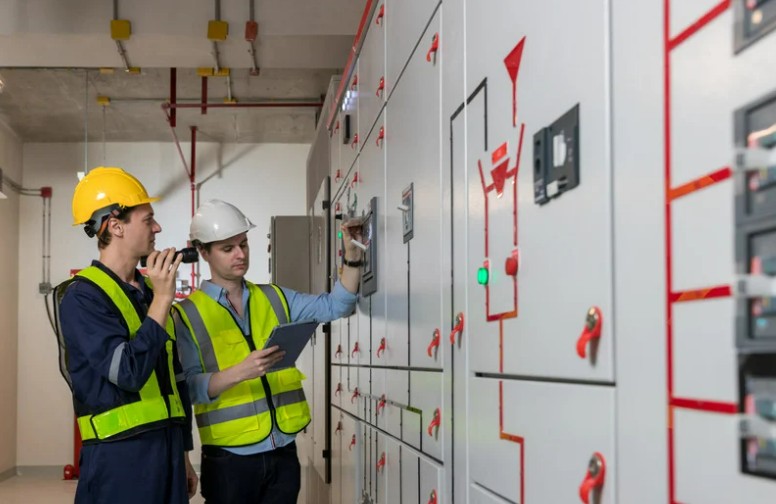Essential Electrical Considerations for Warehouses

A resilient electrical design is the backbone of modern warehouse operations. Think of it as the silent hero that keeps everything running smoothly, from production lines to office computers. Without a reliable electrical distribution system, even the smallest power hiccup can make your entire operation standstill.
Warehouse Operations
A warehouse’s electrical system must be designed for continuous, uninterrupted operations, even when faced with grid issues or lightning strikes. Voltage stability is critical—fluctuations can wreak havoc on machinery and equipment, which could lead to costly downtime.
Power quality is just as important. A stable electricity frequency ensures your products meet quality standards, while minimising harmonic distortion protects sensitive electronics. And let’s not forget scalability—your system should grow with your business without causing disruptions.
Safety
Safety isn’t just a box to tick—it’s a non-negotiable priority. A well-designed electrical system starts with proper installation, using high-quality equipment from trusted suppliers. Regular inspections and maintenance are critical to keeping everything running safely.
Here’s what a robust safety approach looks like:
- Fire detection systems with smoke detectors and heat sensors
- Proper grounding to prevent electrical shocks
- Circuit protection like breakers and fuses to guard against overcurrent
- Compliance with AS/NZS 3000 standards to ensure reliability
Efficiency
With energy consumption in the industrial sector expected to rise by 5% to 32% by 2050, smart design choices can save you big in the long run.
Here’s some tips to help you boost efficiency:
- Strategically place electrical panels and outlets to minimise voltage drop
- LED lighting systems use around 80% less energy than traditional options
- Install smart meters to monitor energy usage in real time
- Perform regular maintenance of HVAC systems
A system that balances upfront costs with low operating expenses and a long lifespan is a win-win for your wallet and your operations.
Planning and Design Best Practices
A well-thought-out design ensures your system meets current needs while leaving room for future growth. Start with a comprehensive site assessment to identify the best locations for electrical panels, transformers and wiring. Next, calculate your power requirements to create an accurate load diagram.
Your system should include:
- High-voltage distribution from the national grid
- Medium-voltage distribution via transformer substations
- Low-voltage distribution for machinery, lighting and HVAC
Environmental factors should also be considered when designing your system. It must be able to withstand humidity, temperature fluctuations, dust and chemicals. Choose equipment with the right protective features for your warehouse’s specific conditions.
Finally, prioritise maintenance. A system that’s easy to troubleshoot and repair minimises downtime. Smart technologies like IoT devices and adaptive control systems can take your monitoring and flexibility to the next level.
Components of Warehouse Electrical Design
Your warehouse’s electrical infrastructure relies on three core components that work together to keep operations running smoothly.
1. Power Distribution Systems
Power distribution networks are the heart of electrical design. They include transformers that convert high voltage from the grid to usable levels. A well-designed system uses circuit breakers to protect against overloads and short circuits.
The distribution framework operates on three levels:
- High-voltage distribution from the national grid
- Medium-voltage distribution via transformer substations
- Low-voltage distribution for machinery and equipment
Busbars act as the main conductors, distributing power throughout the facility. Smart placement of electrical panels ensures stable voltage and minimal energy loss.
2. Lighting Systems
Good lighting is essential for warehouse safety and efficiency. LED lighting systems are a no-brainer—they’re brighter, more reliable and use 60% less energy than traditional options. Try combining artificial and natural light sources to maximise visibility and reduce energy costs.
Your lighting design should include:
- Even illumination across storage areas
- Task-specific lighting for workstations
- Emergency lighting that meets safety standards
3. Emergency Power Solutions
Power outages are inevitable, but they don’t have to disrupt your operations. Backup generators and UPS units ensure critical systems stay online during outages. Regular tests and maintenance checks are essential for keeping these systems ready for action.
Your backup power system should include:
- Automatic transfer switches for seamless power transitions.
- Monitoring systems for real-time status updates.
- Multiple power sources for added reliability.
Integration of Advanced Technologies
Modern warehouses are rapidly embracing automation and smart technologies. By 2027, over 25% of warehouses are expected to be automated, up from 14% today. Your electrical system will need to support this shift to ensure your warehouse and business stay competitive.
Automation and Control Systems
Automation systems require clean, stable power to function properly. Be sure to protect sensitive equipment with extra filtering and surge suppression.
Key considerations:
- Stable power for conveyor systems and sorting equipment
- Clean power for control panels and IoT devices
- Support for both fixed and mobile automation systems
Security and Access Control
Your electrical system must also support advanced security systems, such as:
- Biometric access controls
- Video surveillance systems
- Intrusion detection equipment
These systems need constant power and proper surge protection to remain operational during outages. Battery backups ensure critical security functions stay online.
Compliance with Australian Electrical Standards
In Australia, electrical standards are quite strict—and for good reason. Non-compliance can lead to hefty fines, with offenders facing penalties as high as $840,000 for serious violations.
To ensure your warehouse’s electrical system remains compliant, follow these basic tips:
- Perform regular inspections and testing by qualified professionals
- Keep detailed records of inspections, including visual checks, continuity values, and insulation resistance measurements
- Disconnect unsafe equipment immediately if there’s an issue
- Test RCDs (Residual Current Devices) each month to ensure worker safety
- Always stay on top of maintenance and documentation to avoid costly penalties
Get Expert Guidance From Thompson Power
With over 50 years of combined experience, the team at Thompson Power can help you with all your warehouse electrical needs. From smart planning to seamless installation, we ensure your needs are met with the highest level of attention to detail.
Contact us today and let’s discuss your project.
